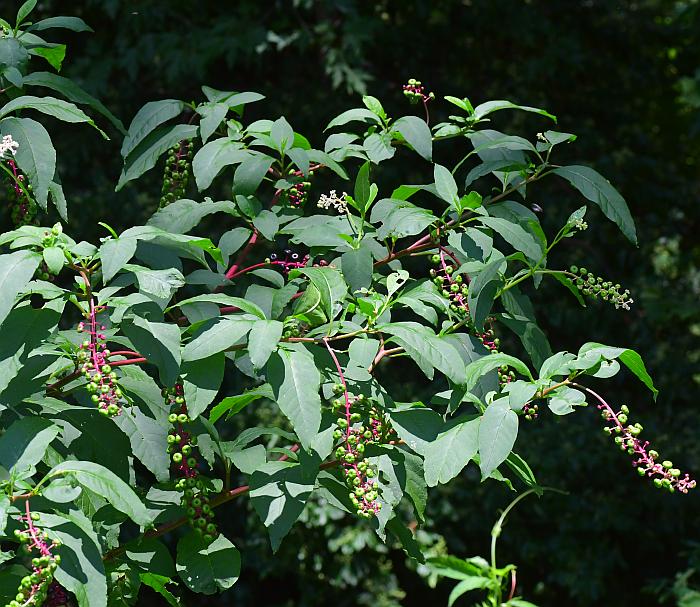Phytolacca americana L.
Pokeweed

Native
CC = 2
CW = 3
MOC = 64
© SRTurner
Phytolacca americana L.Pokeweed | |
 |
Native CC = 2 CW = 3 MOC = 64 |
© SRTurner |
|
Family - Phytolaccaceae Habit - Perennial forb with stout taproot, which can become massive after several years' growth. Stems - Ascending, to 3 m, usually branched, stout, glabrous, often reddish-or purplish-tinged.
Leaves - Alternate, simple, entire, petiolate. Blades 4-30 cm long, oblong-lanceolate to elliptic or ovate, narrowed or tapered to a sharp point at the tip, narrowed at the base, the margins entire or slightly undulate, glabrous, the midvein sometimes reddish-tinged. Venation expressed abaxially.
Inflorescence - Racemes, terminal or appearing axillary or opposite the leaves, 4-25 cm long, often long-stalked, drooping or arched, glabrous. Pedicels to 1 cm long, 4-angled, tuberculate on angles, subtended by a bract, this to 4 mm long, 1 mm broad, also with two small alternate bracts near the midpoint. Inflorescence axis and pedicels whitish in flower, becoming red in fruit.
Flowers - Actinomorphic, mostly perfect, hypogynous. Calyx of 5 sepals, these 2-3 mm long, ovate to nearly circular, white, sometimes pinkish-tinged, often darkening after flowering. Petals absent. Stamens 10, the anthers attached toward their midpoints. Filaments pinkish-white, 2 mm long, glabrous. Pistil 1 per flower, the ovary superior, green, depressed-globose, consisting of 10 carpels in a ring (visible as lobes), each with 1 locule, the placentation more or less basal. Styles 10, each with a linear stigmatic area along the inner side toward the tip. Ovule 1 per carpel.
Fruits - Berries 5-10 mm in diameter, depressed-globose, sometimes slightly lobed at maturity, dark reddish purple to nearly black at maturity, usually somewhat shiny, the juice reddish purple. Seeds 10, 2.5-3.5 mm long, ovoid, slightly flattened, the surface smooth, black.
Flowering - May - October. Habitat - Streambanks, pond margins, bluffs, forest margins, fencerows, pastures, fields, roadsides, railroads, open disturbed areas. Origin - Native to the U.S. Other info - This familiar species is common across Missouri and most of the eastern half of the continental U.S. It also occurs on much of the U.S. west coast, though it is considered introduced there. The plant is recognized by its large size, fleshy stems which are often reddish when older, and berries so deeply purple in color as to appear nearly black. The flowers lose their sepals and anthers quickly, so plants usually has the appearance of being in fruit. Photographs taken in the Ozark Scenic Riverways, Shannon County, MO, 6-24-03 and 6-29-03 (DETenaglia); also at Shaw Nature Reserve, Franklin County, MO, 8-25-2007, Busch Wildlife Area, St. Charles County, MO, 7-26-2008, Weldon Spring Conservation Area, St. Charles County, MO, 5-29-2012, near Labadie, Franklin County, MO, 8-07-2016, Busch Greenway / Duckett Creek, St. Charles County, MO, 6-04-2018, Allenton Access, St. Louis County, MO, 8-02-2020, and along the Katy Trail near Dutzow, Warren County, MO, 6-25-2022 (SRTurner). |